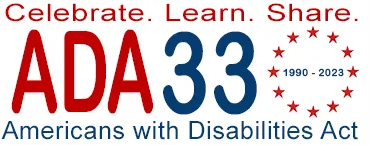DEI In Motion: ADA 33rd Anniversary
July 26th marks 33 years since the Americans with Disabilities Act (ADA) was signed into law in 1990. The ADA was a historic civil rights law that protects the rights of people with disabilities, and ensures equitable access and opportunities. While compliance with ADA standards in AEC (architecture, engineering and construction) industry transportation projects may be top of mind for many WTS Professionals, disability inclusion in the workplace may not be something that we all think about as often. Here are five “E’s” to highlight opportunities to celebrate the ADA and make our workplaces more diverse, inclusive, equitable and accessible for everyone.
- Encourage disability self-identification. The CDC estimates that approximately one in four adults in the U.S. lives with a disability, including non-apparent and invisible ones.[1] However, most people don’t disclose their disability status at work. There are numerous benefits of being able to quantify representation of people with disabilities, including helping employees not feel alone, being able to set goals for increasing representation, and building trust and psychological safety to show employees that the data will be protected and used constructively to help build more inclusive, accessible, and equitable workplaces.
- Ensure that “A” is part of your DEI strategy. DEIA stands for diversity, equity, inclusion, and accessibility and use of this acronym has become more common in recent years since President Biden signed an Executive Order on DEIA in the Federal Workforce in 2021. Many disability advocates call for accessibility to be a part of all workplace DEI strategies. This can be beneficial to bring more people into important conversations and endeavors related to advancing inclusion and belonging for everyone.
- Educate yourself about the challenges of living with disabilities and strategies to improve accessibility. Then implement new techniques to foster awareness, ensure access, and promote inclusion. This could include adding a diversity or accessibility commitment statement to meeting invitations to encourage attendees to request accommodations in advance. Establishing “Mindful Moments” at the beginning of meetings can also serve to recognize that we all see, hear, interact, and learn differently. Assigning a point person and intentionally asking attendees if they require assistance, support, or adjustments to access meeting materials and participate comfortably shows true commitment to accessibility and inclusion.
- Empower employees to easily request workplace accommodations. It’s one thing to be able to provide reasonable accommodations if requested, as required by the ADA, but it’s much more effective and meaningful to proactively help applicants and employees feel encouraged to request accommodations that will help them succeed and flourish. While accommodations can vary widely, research by the Job Accommodation Network (JAN) shows that nearly half of accommodations have low or no cost associated with them.[2]
- Enlighten each other about invisible disabilities. This includes educating about neurodiversity to reduce stigma, normalizing conversations about different working and learning styles, building allyship and promoting requesting accommodations. Employee Resource Groups (ERGs) can provide opportunities for folks to learn, connect, engage, and advocate for workplace neuro-inclusion.
Links to Resources:
- 5 Ways to Make Your Workplace More Neuro-inclusive (fastcompany.com)
- ADA Anniversary Tool Kit (adaanniversary.org)
- Disability IN (disabilityin.org)
- Encouraging Self Identification, EARN- Employer Assistance and Resource Network (askearn.org)
- Executive Orders on Diversity, Equity, Inclusion and Accessibility (commerce.gov)
- From DEI to DEIA: Why Adding Accessibility Is So Important (csescienceeditor.org)
- FTA ADA Regulations
- JAN: Job Accommodation Network
- Make it Safe for Employees to Disclose Their Disabilities (hbr.org)
Citations:
[1] Disability Impacts All of Us Infographic. (cdc.gov)
[2] Nearly Half of Accommodations for Disabled Employees Cost Nothing (shrm.org)

Credit: ADA National Network (adata.org) 1-800-949-4232